Travelling to Argentina and wondering how to navigate the confusing topic of money in Argentina? This guide will help you understand cash, credit cards and more – along with handy tips I picked up living in Argentina for two years.
IMPORTANT! This article has been updated in June 2024, as things change frequently!
If you’re planning a trip to Argentina, you’ve probably stumbled upon a complex topic in your research: money.
Money in Argentina is a unique… confusing… complex situation. It’s unlike any other country I’ve ever been to. With raging inflation and decades of uncertain economic policy, it’s no wonder that visitors and residents alike struggle to wrap their heads around the different forms of currency exchange rates, the infamous mercado azul (blue market) and the ever-changing prices.
As someone who lived in Argentina for two years and grappled with these topics myself, I’m here to share my knowledge and tips on navigating money matters in this beautiful country.
In this guide, I’ll walk you through what you need to know to plan your visit, whether you should bring cash or cards, if you should use ATMs, how to exchange money and more!
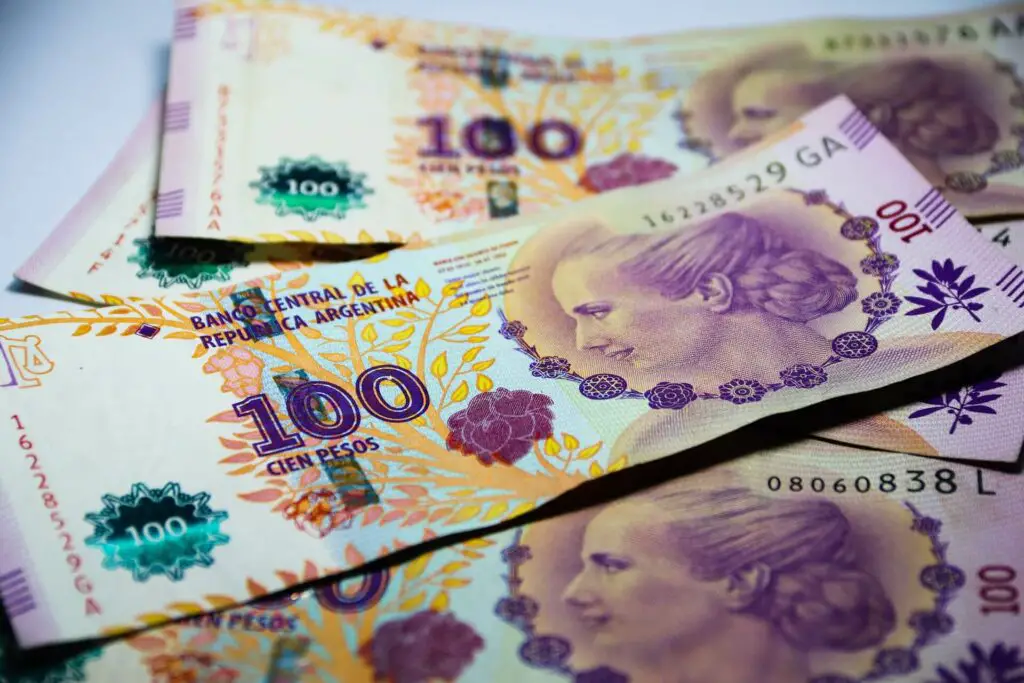
This blog post may contain affiliate links, meaning if you book or buy something through one of these links, I may earn a small commission (at no extra cost to you).
Understanding currency in Argentina
The official currency of Argentina is the Argentine peso, denoted as ARS. On signs, you’ll see the dollar sign ($) used.
The peso comes in various denominations, including coins of 1, 2, 5 and 10 pesos, and bills of 10, 20, 50, 100, 200, 500, 1000 and 2000 (the country introduced the 2000-peso note in 2023 to deal with spiralling inflation, and also phased out the 5-peso bill because it had such little value).
The 1000-peso note is worth less than US$1.50 (depending on the current exchange rate), so you’ll always be carrying large wads of cash with you!
But what you most need to understand is that the Argentine peso has been troubled by severe inflation for decades. This inflation makes the value of the peso quite unstable, with prices of goods and services frequently changing to keep up.
While many countries have been plagued by inflation of 7% or 8% over recent years, inflation in Argentina has reached 180% (and in decades past it’s even hit 20,000%).
It’s not uncommon to walk into a restaurant one day and pay a certain amount for a meal, only to walk in two days later and pay double – or more – for that same meal. Restaurant owners (and other shops) have to constantly adjust their prices to keep up.
This economic instability can be quite a surprise if you’re used to a more stable currency.
It’s tough for a country that was one of the richest in the world at the beginning of the 20th century.
The Blue Market: Argentina’s informal currency exchange
Because of this high inflation, Argentines prefer to hold onto and trade in US dollars, which is seen as a more stable currency.
This situation has led to the development of two distinct markets for exchanging currency. (Well, in fact, there are more than 10 different exchange rates but in this article I’m only going to talk about three!)
There’s the official market, where the government sets the exchange rate, and then there’s the mercado azul or the blue market, where the exchange rate is determined by supply and demand.
It’s not uncommon for the blue market rate to be significantly higher than the official rate – in fact, it can be double or more.
HOWEVER, since the election of Argentina’s new president, Javier Milei, in 2023, the situation has changed somewhat.
Upon taking office, Milei devalued the peso. His ultimate plan is to dollarise the Argentinian economy, although this will be challenging and will take time.
This means that the gap between the official and blue rates has tightened, and you can’t get the same value you once could when exchanging US dollars for pesos.
But then, the gap can grow, making the blue market more attractive.
It varies constantly.
So, ALWAYS check the rates (link below!).
>> Check today’s rates online here <<
Is it still worth it to bring dollars and exchange them on the blue market?
I think it’s still worth bringing US dollars to Argentina and changing them here – either at the official rate or the blue rate.
The reason for this is that ATMs are awful. You can only withdraw a small amount of cash and the fees to do so are high.
I recommend having a mix of US dollars (to exchange to pesos), credit cards and ATM cards when you visit Argentina.

Exchanging money in Argentina
So you’ve brought your US dollars or Euros with you to Argentina – but how do you now get Argentine pesos?
While some restaurants and shops do accept dollars and Euros (there’ll usually be a sign with their rate, usually at the counter), they’re the exception rather than the rule.
Cash is king, so you will need to exchange that foreign currency for pesos. Note that US dollars will usually get a better rate than Euros. And US dollars are easier to change outside of Buenos Aires.
Here are a few ways you can exchange money in Argentina – both officially and on the blue market.
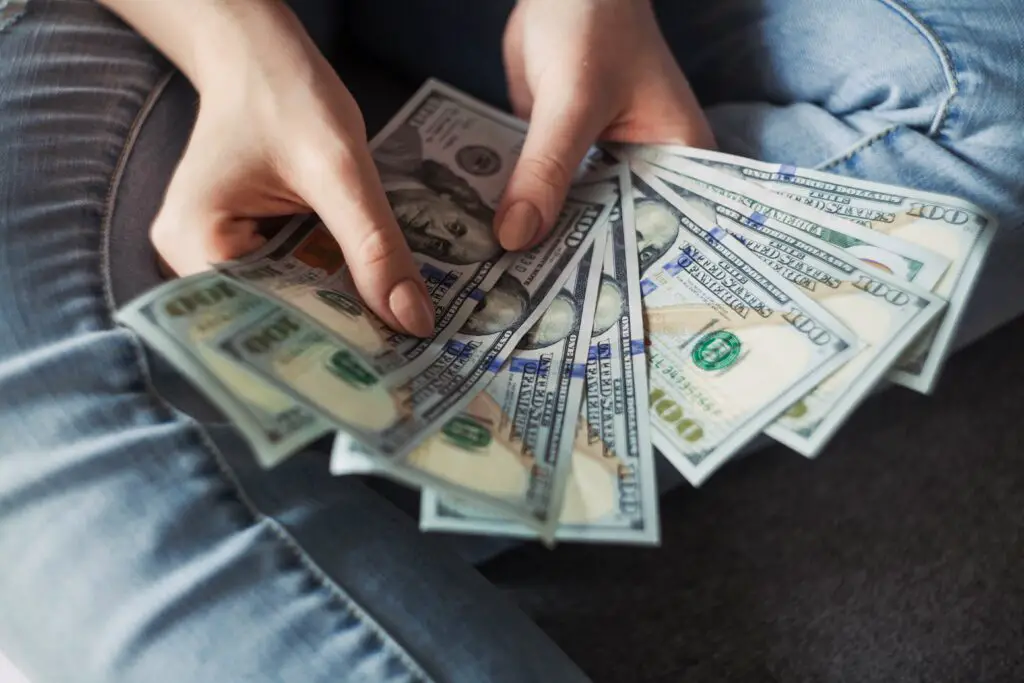
1. Cuevas
Cuevas (which means caves in Spanish) are the informal currency exchange houses that use the blue market rate.
Argentines use cuevas daily, and they’re safe places to exchange money.
I recommend asking your hotel concierge or a trusted Argentine friend for a recommendation for a cueva. While I said they’re safe, there are of course unscrupulous people everywhere who are more than happy to take advantage of a clueless tourist.
You might consider going with an Argentine the first time so you get the hang of it.
This is one of the easiest ways to exchange money in Argentina, and you’ll find cuevas in Buenos Aires and in major cities and towns. There are some recommended cuevas in this Facebook thread.
2. Calle Florida
Wander down Calle Florida (Florida Street) in Buenos Aires’ Microcentro at any time of day and you’ll hear the call of “Cambio! Cambio!”
These people are called arbolitos (or little trees, because they’re always standing there and because of the green colour of US dollars) and they’ll exchange money for you at the blue rate.
The exchange doesn’t happen there on the street – you’ll follow them into a shop or a cueva or even into a newsstand for the swap.
They usually have a machine to check for fake US dollar notes – and you’ll need to check your peso notes carefully as well when they’re handed over to you.
This was how I first exchanged money when I moved to Argentina and it did feel strange! They’re usually pretty safe – but trust your gut and keep walking if a situation doesn’t feel safe. Some have been known to notify their mates out on the street who will then rob people of the cash they’ve just collected.
One of the advantages of changing money on Calle Florida is that you can go from arbolito to arbolito for the best rate, so shop around before you exchange.
3. Currency exchange houses and banks
If the blue market makes you nervous, then stick with regular currency exchange houses like banks. They will, of course, use the official rate.
You might consider this when you first land in Buenos Aires, just so you have a little bit of cash on you. This’ll be handy to pay for your trip into the city (taxis don’t take credit cards) if you haven’t organised a transfer from the airport.
There’s a Banco La Nacion in Ezeiza International Airport where you can change a few dollars into pesos.
Hotels can also exchange money for you, as well as exchange bureaus (casas de cambio), which can be found around the city. Ask your hotel for the nearest casa de cambio.
You’ll need ID to exchange money at banks and exchange bureaus.
Western Union in Argentina
Carrying a large amount of cash anywhere can be nerve-wracking.
If you don’t want to bring a lot of US dollars or Euros in cash with you to Argentina, then Western Union is a great option. You can send money to Argentina using their service.
Western Union can provide you with an exchange rate that’s around the same or even higher than the blue rate (however keep in mind the pretty high fee that Western Union charges). Western Union uses the Dolar CCL as reference.
So, how to send money to Argentina with Western Union?
It’s quite simple: you send the money from your home bank account to yourself and then pick up the cash at a local Western Union branch.
It’s an efficient way to transfer money from your home country to Argentina without carrying large amounts of cash. Do remember that some transactions can take a few days to process, so plan ahead. The lines can also be pretty long some days, so schedule a few hours into your day’s itinerary, just in case.
There are several Western Union branches in Buenos Aires – including one at Ezeiza International Airport (although the opening hours aren’t great if you’re arriving early in the morning or late at night).
Outside of Buenos Aires, there are also Western Union branches. Some have withdrawal limits, though, so you’ll need to check before you do a transfer.
Again, check the Western Union rate before you decide. The conversion rate can be found online here.
Credit cards in Argentina
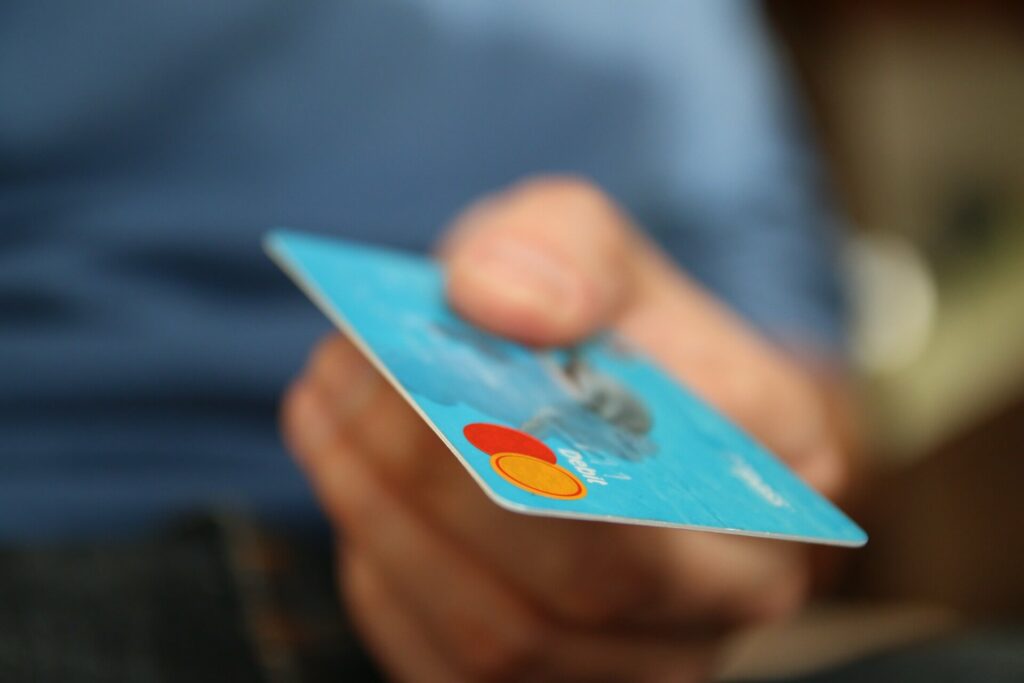
When I lived in Argentina, I rarely paid for anything with a credit card, except for clothes and when we did our full grocery shop each week. At restaurants, cafés and convenience stores I always had cash on hand. At that time, credit cards charged the official rate, so I was always better off paying in cash.
However, since late 2022, foreign credit cards now receive a better rate. It’s called the MEP rate (you can find the latest MEP rate online here) and it’s usually just shy of the blue dollar rate but higher than the official rate.
At the time of updating this article (June 2024), those rates were:
- Official rate: $933,76
- Blue market rate: $1225,00
- MEP rate: $1216,64
If you use a foreign card in Argentina, this MEP rate will apply. Visa will charge you that rate at the time of purchase, while Mastercard charges the official rate and then refunds the difference a few days later.
This is another good way to avoid carrying huge amounts of cash.
On the topic of credit cards, American Express is rarely accepted anywhere, so leave that card behind.
But you need to keep in mind that credit cards aren’t always the most practical option in Argentina.
In larger cities, most upscale restaurants, hotels and retail outlets readily accept credit cards. But in smaller shops and restaurants – and in smaller towns in Argentina – cash is usually the only accepted form of payment.
Always ask before you sit down in a restaurant if they take credit card: “Acepta tarjeta?”
Either way, you’ll always need to have some amount of cash on you when you’re travelling around Argentina.
Speaking of restaurants, here are 50 of my favourite places to eat in Buenos Aires.
Expert traveller tip: If you’re going to rely on credit cards, always bring a backup credit card in case you have any issues with your main card. Make sure that back up card is a different type (Mastercard, Visa etc). I’ve had cards rejected multiple times when overseas so learned this trick pretty quickly!
Using ATMs in Argentina
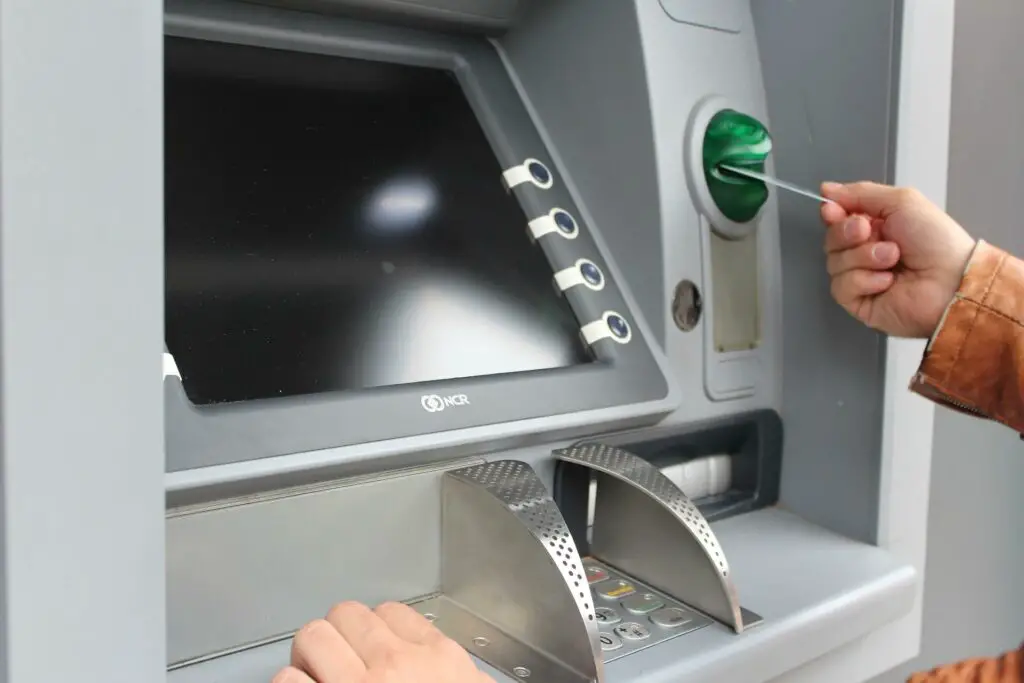
Should you use ATMs in Argentina?
This one’s easy: avoid using ATMs as much as you can!
In Argentina, ATMs have low withdrawal amounts and high fees, so you’ll be getting screwed all round.
ATMs should only be used as a back-up or last resort method for accessing pesos.
One important thing to note is that ATMs often run out of cash ahead of weekends and public holidays, so if you do think you’ll need to withdraw cash, do it as soon as possible.
Argentina money tips
When it comes to handling money in Argentina, here are a few handy tips I’ve learned from experience:
- Avoid exchanging money into pesos before you arrive in Argentina.
- Bring US$100 notes – the cleaner and crisper, the better. You’ll get a better rate for these in the cuevas.
- Cuevas will rarely want to change US$10 or US$20 notes. I’ve changed US$50 notes, but it was done reluctantly.
- Keep some small peso notes on hand – trust me, many shop owners aren’t fond of giving change.
- Be aware of money restrictions on bringing USD into Argentina. Like most countries around the world, there’s a $10k limit without having to declare it.
- I’d recommend booking hotels and tours in advance online using your credit card. It simplifies things and cuts down the amount of cash you need on hand.
- If you’ve got pesos left over at the end of your trip, spend them! You’ll get a lousy rate transferring them back to US dollars or Euros. Buy some souvenirs in Buenos Aires to take home with you.
- Don’t get too hung up on the blue rate! Even at the official rate you’ll (usually) find Argentina an affordable destination.
Safety and security considerations
Carrying large amounts of cash and one or two credit cards can make you nervous. Remember, carrying the equivalent of US$50 means you’ll have around 45 x 1000-peso notes on you! That’s a stack of cash.
When it comes to keeping your money safe in Argentina, a few practical accessories can make all the difference:
- Money belt: May seem tacky, but it’s a relatively discreet way to carry money, provided you don’t access it in public.
- Passport scarf: These are actually quite useful – a stylish and less conspicuous way to keep your money and passport safe.
- Anti-theft backpack: Hidden zippers and slash-resistant materials provide an extra layer of security for your belongings.
- Lock: Keep your backpack or suitcase locked up when it’s unattended in your hotel room.
Remember, no safety device is foolproof. Argentina is a fairly safe country, but always stay alert and practice common sense in public spaces.
Final thoughts: Money in Argentina
So after reading this Argentina money guide, what money should you bring to Argentina?
I recommend:
- Bringing US dollars or Euros to exchange into pesos for use in restaurants and places that don’t accept credit cards – work out in advance how much money you think you’ll need for each week of your Argentina itinerary
- Bringing credit cards for bigger purchases at larger restaurants, shopping centres and so on – and don’t forget a back-up credit card
- Booking hotels and tours in advance (on your credit card in your home currency)
- Using Western Union to send yourself money and avoid carrying a large amount of cash – this is the best option if you’re travelling for a long time in Argentina
BUT, before you make your final decision, always check the latest exchange rates.
Money in Argentina: FAQs
Can I use travel cards in Argentina?
You can use travel cards (like Wise) in Argentina, but you’ll get an even worse rate than the official rate. Plus you’ll be dealing with the same challenges as using a credit card – not everyone accepts credit card. A Wise card might be a good back up option, but it shouldn’t be what you rely on for accessing money in Argentina.
Can I use traveller’s checks in Argentina?
I don’t know anyone who uses traveller’s checks these days! But if you insist… Yes, you can exchange traveller’s checks in Argentina, but you’re going to spend your time in banks doing the exchange. Time that is better spent out enjoying the city!
Is it better to use cash or credit cards in Argentina?
While credit cards are widely accepted in cities and larger towns, smaller establishments and vendors in rural areas may only accept cash. It’s best to carry a mix of both for convenience.
Can I withdraw money from ATMs in Argentina?
Yes, ATMs are available across Argentina. However, withdrawal fees can be high, and the exchange rate may not be as favourable as the blue market rate. Don’t forget to inform your bank about your travel plans to avoid any potential issues with using your card abroad.
What is the blue market in Argentina?
The ‘blue market’ refers to the unofficial currency exchange market in Argentina where US dollars or Euros can be exchanged for Argentine pesos at a rate higher than the official exchange rate. This isn’t always the case and it changes as governments introduce new economic policies.
Are US dollars accepted in Argentina?
While some places in Argentina may accept US dollars, it’s always more practical to use Argentine pesos. You can exchange your US dollars at a blue market exchange for a better rate.
How safe is it to carry cash in Argentina?
As with any travel destination, carrying a large amount of cash can carry some risk. However, with sensible precautions such as using a money belt or anti-theft backpack, it’s usually safe. Always be alert in public spaces and avoid showing that you’re carrying a large amount of money.
Did you find this article helpful? Consider buying me a coffee as a way to say thanks!
Got any questions about using money in Argentina for your upcoming travels? Drop them in the comments below.
Related posts
Before you go… you might like these Argentina travel blogs:
- Argentina itinerary ideas: Options for 1-4 weeks
- Plan a Trip to Argentina: 19 Travel Tips for First-Time Visitors
- Travel Insurance for Argentina: What You Need to Know
- Renting a Car in Argentina: 17 Helpful Tips and Tricks
ARGENTINA TRIP ESSENTIALS
- Book your flight to Argentina online with Skyscanner. I like how this site allows you to find the cheapest days.
- Find a great hotel in Argentina. Check prices on Booking.com and Expedia online.
- Check out the huge range of day tours throughout Argentina on GetYourGuide or Viator. There’s something for everyone.
- Keep those bottles of wine you’ll be buying safe in these wine bags.
- A copy of the Lonely Planet guide to Argentina will be handy. Also pick up a Spanish language guidebook to help you navigate your visit.
- One thing I always purchase is travel insurance! Travel Insurance Master allows you to compare across multiple policy providers, while SafetyWing is great for long-term travellers and digital nomads.
PIN IT FOR LATER
Save this guide to money in Argentina to Pinterest for later.
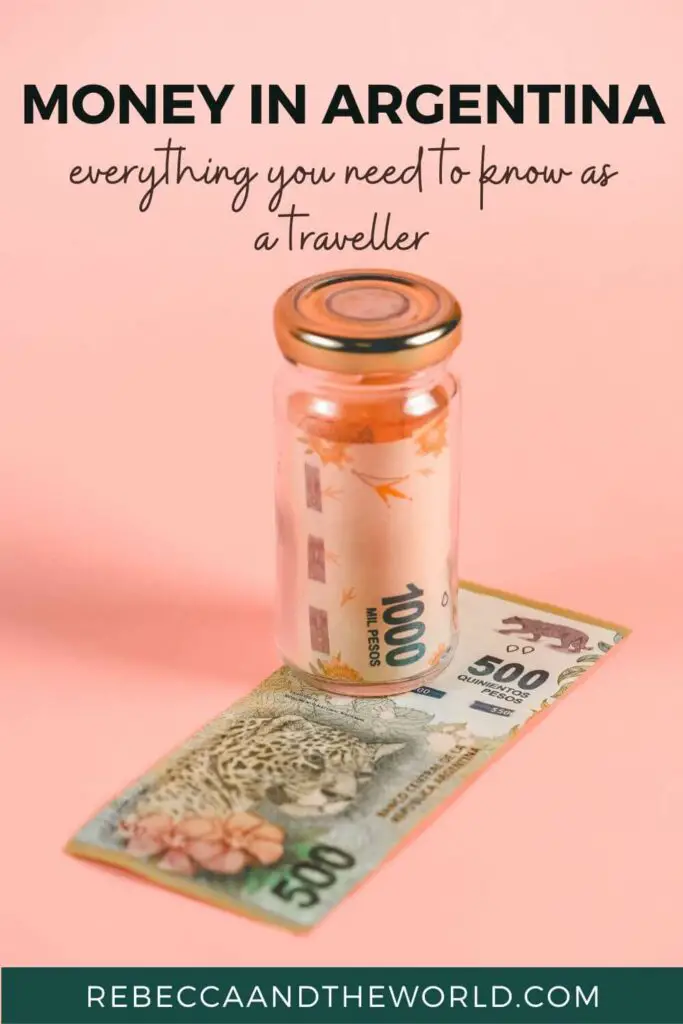


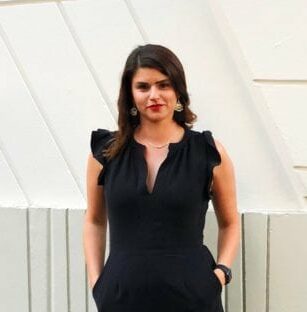

I recently retired and I would like to live in Argentina for a couple of years.
What about establishing a bank account in Argentina and the interest rate on savings there? Did you happen to use a bank for savings in Argentina when you lived there? If so, how do those banks deal with savings account interest payments?
I see on different websites that people recommend Banco de Galicia but there are no hints a to why.
Hi David, Thanks for the question – I wish I had better information to help you. I had a bank account (with BBVA) but it was purely so I could access pesos. I didn’t use it for savings and preferred to keep my savings in my home country (Australia) at a higher, guaranteed interest rate. There’s an expat Argentina group on Facebook that may be more helpful than I have been here! Enjoy living in Argentina – it truly is an incredible country!
Hi Rebecca, I’m an argentinean leaving abroad for long time now and I found this article great. It’s so difficult to keep track of all the changes, your details and recommendations are awesome. Thanks!
Thanks Leo, glad it was helpful!
Hi Rebecca.
I recently returned from a trip to Argentina and paid for all of my meals with a US credit card (Visa) as well as paying for my hotel in Mendoza with US Mastercard. All of the transactions were charged in peso’s but I was not given the MEP rate. It appears that all of the charges were converted at the official rate. It has been 10 days since the last charges and no refunds or adjustments on any of my cards. Any update on AR government changing rate adjustment for purchases with US credit cards receiving MEP rate?
That’s so frustrating, Steve! Did you reach out to your credit card provider? There has been no change, as far as I know. Luckily the split right now between the MEP and official dollar isn’t that wide, but still!!
I have been living in Argentina for almost 3 years now and if you do not use cash you will pay more. You will NEVER get a good deal with a credit or debit card. MEP rates rarely apply and even if you try to pay things in dollar amounts they will absolutely every time scam you… using the sell blue dollar rate then adding 15% more for not using cash and buying blue dollars (crisp clean unmarked $100 USD) for usually a lower blue dollar rate than is posted anywhere. The only way to immediately get the best rate possible is to use Western Union. Period. This is not an easy task in itself, but there is no easy way to get good rates in Argentina.
Here is what you do: download the Western Union app, you can even get updates as the Western Union rates change (Western Union rate is not one of the seven current USD rates but it should be as in the last 3 years I have rarely seen any other rate as good as theirs). After you have the app, the moment you send yourself the money the exchange rate displayed is locked in an you will receive an email within minutes containing the code needed to withdraw your ARS (Argentina pesos), often with NO fees from a debit card use on the app. Biggest problem is that many Western Union locations in Argentina do not have large amounts of cash on hand. So, ask them first. Find out how much in pesos you can withdraw now, send yourself that much in pesos to withdraw and be on your way. Only other issue is that Western Union is often a payment center for anything from online orders to electric bills and especially at the beginning of the month they have long lines where you can expect to wait 1-2 hours in line before you can even talk to anyone, but they usually have more cash on hand at the beginning on the month due to this so it’s a catch 22. Cheerful wishes and good luck!
Thanks for these insights, Jeremy! Western Union is a good option – but as you say, there are a few cons to using it.
Thanks for a good review of the quite complex question regarding argentinian currency. There is one thing i havnt been able to find out information about, and was wondering if maybe you knew. On the site you linked (and other sites) with the different exchange rates for ARS there is one rate called “dolar turista” that is about 40% higher than the “dolar MEP”. What is this about?
Hi Rocky, good question! The dolar turista is the rate for Argentines when they’re buying things from abroad using their credit card (ie. shopping online or if they’re travelling overseas). So, nothing to do with tourists IN Argentina. All very confusing right?!
Hi Rebecca,
I am Canadian and usually travel with a couple of credit cards, Canadian and US $100 bills. In South East Asia there was no problem exchanging the Canadian $100 bills for their currency at the street cambios. Can I exchange $100 bills to ARS on Calle Florida? Hope to go to BA next January for a couple of months. Thanks
Hi Lyse! I’m not familiar with people trying to change Canadian dollars for pesos… I think you’ll have much better luck with USD. Certainly, you could change Canadian dollars in official currency exchange houses, but highly unlikely with the street changers or cuevas. Your other option is of course Western Union.
(Having said that, check the rates as you get closer to your travel date – if it’s anything like right now and the spread between the official and blue market rates continues to be so slim, there’ll probably be little difference to changing on the street/in cuevas versus the official currency exchange places.)
Hi Rebecca! This is very helpful specially with the new president I think things have changed a lot… My question is, what is the best way to book hotels and such and get the most out of your dollar? Any tips on that?
Hi Diana! To be honest, I’d usually book via a site like Booking.com or Expedia – so I know exactly what I’m paying and there are no surprises when you arrive and maybe there’s a different exchange rate than you expected. I also like those sites because I can book refundable accommodation if I change my mind. And way easier than having to email hotels directly to find out their exchange rates etc. Hope that helps!
Great article, Rebecca…thank you! One question, since we have lots of tours planned. For gratuities to tour guides, how would they prefer to be tipped? USD? Thank you so much!
I think either pesos or USD would be much appreciated! Everyone will have different preferences – you could ask them first (they’ll understand why you’re asking given how complex money in Argentina is!!).
Hi Rebecca, thanks this is super helpful. We are traveling to Argentina in a week from Ireland. The MEP rate seems to be better than the blue rate at the moment according to https://www.lanacion.com.ar/dolar-hoy/. Is this your experience? And does this mean it is better to use credit cards in and around Buenos Aires? Is there a good app to download that allows you to quickly compare rates?
Do you think I better changing Euros to USD before I come, or bringing Euro?
Also do you know if Brazilian Real can be purchased in BA? thank you in advance!! Aran
Hi Aran, The rates change regularly, that’s right! They’re on par at the moment. You can use your credit card – but you do need to have cash because not every restaurant/business/cafe accepts credit card. So use a mix of both so you’re not caught out.
The newspaper websites are the most up-to-date with the rates, they’re what I’ve always referred to… I don’t think there is an app that shows the rates (but I could be wrong – I’ve just never needed one).
Euros will be fine, but you will usually get a better rate with USD (and USD is more readily accepted by money changers).
I’ve never actually purchased reales in Buenos Aires, but I’m sure you can – you’ll need to go to an official currency house to do, though.
Have a great trip – hope this helped!
I know your article is about money and it’s very useful, I’m just wondering off topic about the Mosquito situation. I was planning a stay in April but started reading about the significant infestation of mosquitoes plaguing the country. Is this a major situation that makes walking and enjoying the nights unbearable?
Hi Michael, the weather will be cooler in April so the chance of mosquitoes should be much lower!! Right now it’s not fun in certain parts, but it should improve by April.
When I make a reservation for a hotel room that is quoted $200 USD and I pay with my credit or debit card, will my rate be adjusted based on the official rate of exchange? Sheila S.
It depends – how are you paying? If on a website like Booking.com, then the quoted rate will be as it is. If you have arranged with a hotel directly, then it will determined by them which rate you use.
Hi Rebecca,
I would pay for hotels with my visa card. I typically reserve on the hotel site. Some are American hotels such as Marriott and others would be Argentine. For example if the hotel price is quoted as $200 USD, would it be calculated based on the exchange rate and ultimately be less than $200 USD? I am trying to budget accordingly.
Thank you.
Hi Sheila, for an American site, you can expect to pay in USD always. For an Argentine site, you’d need to check with each one directly, as each hotel charges differently and would likely use a different rate. Have a great trip!
Hi Rebecca, really appreciated your article.
Being an Aussie I was wondering if you had any experience with exchanging AUD to ARS whether through Western Union or the other ways mentioned above. Did you use any Australian credit cards to make purchases? I have a Wise Travel card and card with Commonwealth Bank, so curious to see if you used any of them whilst in Argentina. Additionally when you went to El Calafate and El Chalten what were your experiences with making purchases there via card and cash? Were taxis/car rental/buses usually card or cash?
Cheers
Hi Nicole! I’ve never transferred AUD via Western Union – but I always used my Aussie credit cards when I lived there (along with exchanging USD in cash into pesos). I’d check with your bank just to be 100% sure but I never had a problem with them (I used my Aussie credit cards for grocery shops, larger restaurants, clothes, bars etc).
Taxis and public transport are always cash – everywhere in the country, even in Buenos Aires (although you can use Uber in BA).
I’ve never used a Wise travel card there, I’m afraid!
We have just returned from Argentina and Chile. We found your site a good guide before we left.
Western Union worked ok and we got1280 pesos to the pound. We were not aware that you have to withdraw the whole amount that you transfer. We were under the impression we could call it off in bits. Some Western Union outlets have limits on how much you can withdraw so we had to go to the main branch in Buenos Aires.
Monzo card worked perfectly in Chile and Argentina. We got a rate of 1400 pesos to the pound on it.
Thanks Sue – that’s great to know about not being able to withdraw in smaller amounts.
Glad you had a great trip!
Is there any difficulty getting dollars back OUT of Argentina? I need to travel to Buenos Aires to settle some affairs, and want to take the proceeds back to the U.S. with me. But I’ve been told there are hefty fees for taking dollars out of the country. However, I can’t find any information about that online. So… is it true?
Hi Emjay, I can’t find much info on this either. I think your issue would be the country that you’re next going to, they’re likely to have a $10k import limit as well?
Speaking of cash, I was wondering about tipping in Buenos Aires. Do I need some pesos or will small US dollars be ok? Or is tipping even expected? Leaving in about 30 days and will only be in BA for 2 days.
Would the same be true for other countries such as Chile and Peru?
Thanks for your excellent advice.
Hi Judy, small peso notes are usually best for tipping – that makes it easier for staff/businesses to actually use it (rather than then having to exchange it if you tipped them with USD).
From my experiences visiting Chile and Peru, tipping is also voluntary – but always appreciated. Again, using the local currency when tipping is best.
Have a great trip!!
In february 2023, the Western Union office at the airport was closed permanently. So we had to withdraw pesos at the official change rate.
Thanks for sharing this, will update the article!
Are Uruguayan pesos accepted?
Hi Diane, No, Uruguayan pesos aren’t accepted in Argentina. In Buenos Aires some stores may accept Brazillian reals, but never Uruguayan pesos.
You’ve done a great job with this discussion and I wish I had read it prior to arriving in BA from the US in mid November 2023. Slightly stronger language about the official vs. the non-official exchange rates would be helpful. For example, on one site the writer said it is best to consider Argentina a “cash only country,” which drives home the point that you will be better off estimating your spending and bringing that amount of dollars. To estimate it’s important to decide if you’re going to exchange at the official rate or at the much much better unofficial or “blue” rate”. You say peso prices are still “affordable” at the official rate, which I agree with; however, remember that the blue rate has lately (November/December’23) been about 168 percent better than the official rate! That’s on everything you pay for with your ARS pesos. Usually “doubling your money” is not real, but this is real, easy, and safe and is actually *more than doubling* the value of your dollars. One last comment: Western Union is indeed a very good option here- compared to usually being a last resort in the USA- as you describe because their fee, which be US$37. is virtually negligible considering the practically surreal amount of additional pesos you’re getting using the [slightly downward adjusted] blue rate that Western U. gives you. The WU app works well and you’ll know the exact exchange rate you’re getting and any transaction fee they may charge. Your first transaction usually has “no fee”. Take USD cash, get the best rate with that, and, if you underestimate, use WU. Rebecca makes excellent additional points on my points and on WU.
Thanks David. It’s a tricky thing to navigate in Argentina! I’ve kept the article quite general as things do change regularly in Argentina – sometimes the blue rate does double your money, other times it’s only slightly higher. Hopefully it helps anyone who is planning their trip!